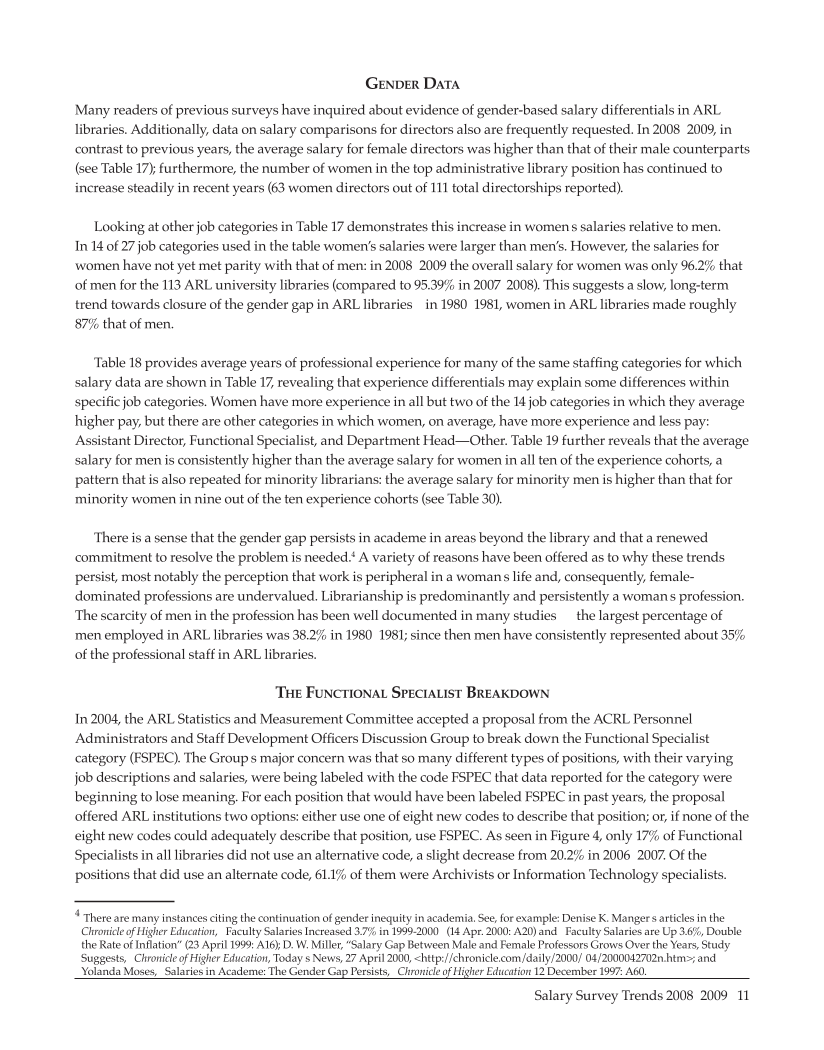Salary Survey Trends 2008–2009 · 11 Gender Data Many readers of previous surveys have inquired about evidence of gender-based salary differentials in ARL libraries. Additionally, data on salary comparisons for directors also are frequently requested. In 2008–2009, in contrast to previous years, the average salary for female directors was higher than that of their male counterparts (see Table 17) furthermore, the number of women in the top administrative library position has continued to increase steadily in recent years (63 women directors out of 111 total directorships reported). Looking at other job categories in Table 17 demonstrates this increase in women’s salaries relative to men. In 14 of 27 job categories used in the table women’s salaries were larger than men’s. However, the salaries for women have not yet met parity with that of men: in 2008–2009 the overall salary for women was only 96.2% that of men for the 113 ARL university libraries (compared to 95.39% in 2007–2008). This suggests a slow, long-term trend towards closure of the gender gap in ARL libraries – in 1980–1981, women in ARL libraries made roughly 87% that of men. Table 18 provides average years of professional experience for many of the same staffing categories for which salary data are shown in Table 17, revealing that experience differentials may explain some differences within specific job categories. Women have more experience in all but two of the 14 job categories in which they average higher pay, but there are other categories in which women, on average, have more experience and less pay: Assistant Director, Functional Specialist, and Department Head—Other. Table 19 further reveals that the average salary for men is consistently higher than the average salary for women in all ten of the experience cohorts, a pattern that is also repeated for minority librarians: the average salary for minority men is higher than that for minority women in nine out of the ten experience cohorts (see Table 30). There is a sense that the gender gap persists in academe in areas beyond the library and that a renewed commitment to resolve the problem is needed.4 A variety of reasons have been offered as to why these trends persist, most notably the perception that work is peripheral in a woman’s life and, consequently, female- dominated professions are undervalued. Librarianship is predominantly and persistently a woman’s profession. The scarcity of men in the profession has been well documented in many studies — the largest percentage of men employed in ARL libraries was 38.2% in 1980–1981 since then men have consistently represented about 35% of the professional staff in ARL libraries. The Functional Specialist Breakdown In 2004, the ARL Statistics and Measurement Committee accepted a proposal from the ACRL Personnel Administrators and Staff Development Officers Discussion Group to break down the Functional Specialist category (FSPEC). The Group’s major concern was that so many different types of positions, with their varying job descriptions and salaries, were being labeled with the code FSPEC that data reported for the category were beginning to lose meaning. For each position that would have been labeled FSPEC in past years, the proposal offered ARL institutions two options: either use one of eight new codes to describe that position or, if none of the eight new codes could adequately describe that position, use FSPEC. As seen in Figure 4, only 17% of Functional Specialists in all libraries did not use an alternative code, a slight decrease from 20.2% in 2006–2007. Of the positions that did use an alternate code, 61.1% of them were Archivists or Information Technology specialists. 4 There are many instances citing the continuation of gender inequity in academia. See, for example: Denise K. Manger’s articles in the Chronicle of Higher Education, “Faculty Salaries Increased 3.7% in 1999-2000” (14 Apr. 2000: A20) and “Faculty Salaries are Up 3.6%, Double the Rate of Inflation” (23 April 1999: A16) D. W. Miller, “Salary Gap Between Male and Female Professors Grows Over the Years, Study Suggests,” Chronicle of Higher Education, Today’s News, 27 April 2000, http://chronicle.com/daily/2000/ 04/2000042702n.htm and Yolanda Moses, “Salaries in Academe: The Gender Gap Persists,” Chronicle of Higher Education 12 December 1997: A60.
























































































































